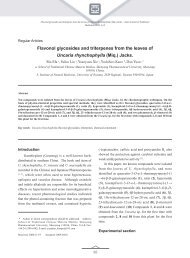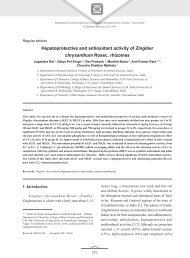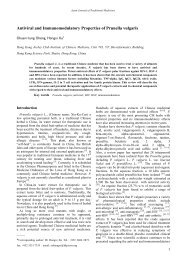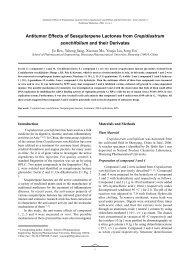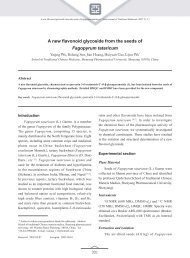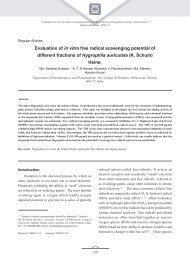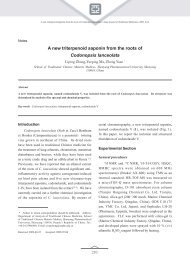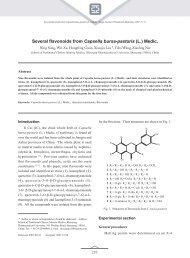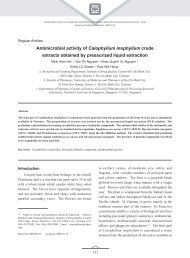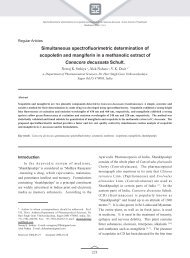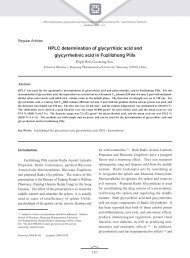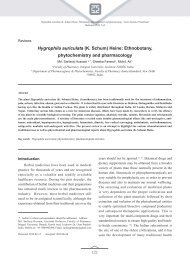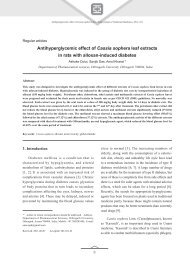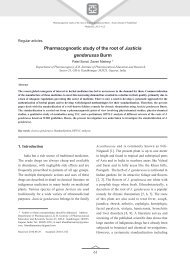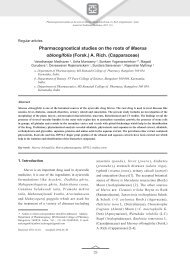Chemical composition of the essential oils of Stevia rebaudiana ...
Chemical composition of the essential oils of Stevia rebaudiana ...
Chemical composition of the essential oils of Stevia rebaudiana ...
You also want an ePaper? Increase the reach of your titles
YUMPU automatically turns print PDFs into web optimized ePapers that Google loves.
<strong>Chemical</strong> <strong>composition</strong> <strong>of</strong> <strong>the</strong> <strong>essential</strong> <strong>oils</strong> <strong>of</strong> <strong>Stevia</strong> <strong>rebaudiana</strong> Bertoni leaves<br />
/ Asian Journal <strong>of</strong> Traditional Medicines, 2010, 5 (2)<br />
while in <strong>the</strong> United States it is used as a dietary<br />
supplement and in Bangladesh as an antidiabetic<br />
tea. <strong>Stevia</strong> <strong>rebaudiana</strong> Bertoni sweetener extracts<br />
have been suggested to have a beneficial effect on<br />
human health because <strong>of</strong> <strong>the</strong>ir antihypertensive [10-11] ,<br />
antihyperglycemic [12] , anticariogenic [13] and antihuman<br />
rotavirus activities [14] . These sweeteners are<br />
also thought to influence glucose metabolism [15-16]<br />
and renal function [17] . The increasing importance<br />
<strong>of</strong> <strong>essential</strong> <strong>oils</strong> in various areas <strong>of</strong> human activity<br />
(pharmacy, cosmetics as well as <strong>the</strong> food and drink<br />
industries) has made this field very interesting<br />
for chemical investigators. Current research into<br />
<strong>Stevia</strong> <strong>rebaudiana</strong> Bertoni <strong>essential</strong> oil, is very<br />
active. However, it should be remembered that <strong>the</strong><br />
sweetening effect is simply a pleasant by-product. The<br />
primary reason that stevia is combined with o<strong>the</strong>r<br />
herbs is to enhance <strong>the</strong> nutritive value <strong>of</strong> <strong>the</strong>se o<strong>the</strong>r<br />
herbs! <strong>Stevia</strong> is, after all, nutrient-rich, containing<br />
substantial amounts <strong>of</strong> protein, calcium, phosphorous<br />
and o<strong>the</strong>r important nutrients [18-19] .<br />
Carrying <strong>the</strong> above considerations a step fur<strong>the</strong>r,<br />
<strong>the</strong>re are many very legitimate reasons for using<br />
stevia as a medicinal food. In spite <strong>of</strong> <strong>the</strong> prominence<br />
stevia has attracted as a flavor enhancer, it contains<br />
a variety <strong>of</strong> constituents besides <strong>the</strong> steviosides<br />
and rebaudiosides, including <strong>the</strong> nutrients specified<br />
above and lots <strong>of</strong> sterols, triterpenes, flavonoids, and<br />
tannins, as well as being an extremely rich volatile<br />
oil containing lots <strong>of</strong> aromatic agents, aldehydes,<br />
monoterpenes and sesquiterpenes [20] . These and o<strong>the</strong>r,<br />
as yet unidentified constituents, probably have a variety<br />
<strong>of</strong> effects on human physiology and may help explain<br />
some <strong>of</strong> <strong>the</strong> reported <strong>the</strong>rapeutic uses <strong>of</strong> stevia.<br />
Therefore, <strong>the</strong> aim <strong>of</strong> <strong>the</strong> present study is to<br />
examine <strong>the</strong> chemical <strong>composition</strong> <strong>of</strong> <strong>the</strong> <strong>essential</strong> <strong>oils</strong><br />
isolated from <strong>the</strong> leaves <strong>of</strong> <strong>Stevia</strong> <strong>rebaudiana</strong> Bertoni<br />
by GC–MS.<br />
Material and methods<br />
Plant material<br />
The green leaves <strong>of</strong> <strong>Stevia</strong> <strong>rebaudiana</strong> Bertoni<br />
were collected from <strong>the</strong> Bangladesh Sugarcane<br />
Research Institute, Ishurdi, Pabna, Bangladesh. The<br />
plants were harvested during <strong>the</strong> month <strong>of</strong> September,<br />
2009. The leaves were collected at 2:00 pm-3:00 pm<br />
on September 2, 2009 and packed in polyethylene<br />
bags and stored at 4 °C until required. All chemicals<br />
used were <strong>of</strong> research grade purity.<br />
GC-MS analysis<br />
The GC–MS analysis <strong>of</strong> <strong>the</strong> <strong>essential</strong> oil samples<br />
<strong>of</strong> <strong>Stevia</strong> <strong>rebaudiana</strong> Bertoni was performed using a<br />
Varian GC–MS instrument (Model Varian CP 3800,<br />
USA) equipped with a VF-5 fused silica capillary<br />
column (30 m×0.25 i. d. mm film thickness 0.25 µm,<br />
Varian, USA). For GC–MS detection, an electron<br />
ionization system with ionization energy <strong>of</strong> 70 eV<br />
was used. Helium gas was used as a carrier gas at<br />
a constant flow rate <strong>of</strong> 1 ml/min. The injector and<br />
mass transfer line temperatures were set at 250 °C<br />
and 300 °C, respectively. The oven temperature was<br />
programmed from 50 °C to 200 °C at 8 °C/min, and<br />
<strong>the</strong>n kept iso<strong>the</strong>rmal for 20 min and finally raised to<br />
300 °C at 10 °C/min. Diluted samples (1/100 v/v, in<br />
methanol) <strong>of</strong> 0.2 µl were manually injected in splitless<br />
mode. Identification <strong>of</strong> compounds <strong>of</strong> <strong>the</strong> <strong>essential</strong> oil<br />
was based on GC retention times on <strong>the</strong> VF-5 capillary<br />
column, with computer matching <strong>of</strong> mass spectra with<br />
those <strong>of</strong> standards (Mainlab, Replib and Tutorial data<br />
<strong>of</strong> GC–MS systems).<br />
Extraction and isolation <strong>of</strong> <strong>essential</strong> oil<br />
The air-dried leaves and stems (250 g each)<br />
<strong>of</strong> <strong>Stevia</strong> <strong>rebaudiana</strong> Bertoni were subjected to<br />
hydrodistillation for 3h using a Clevenger type<br />
apparatus. The distillate was mixed with 1g NaCl and<br />
20 ml dichloromethane (DCM) in a separatory funnel,<br />
and shaking was continued by hand for 40 min and <strong>the</strong><br />
mixture was <strong>the</strong>n allowed to stand for 15 min. Finally,<br />
<strong>the</strong> DCM layer was collected in a round bottom flask<br />
for rotary evaporation and evaporated at 30 °C until<br />
57



